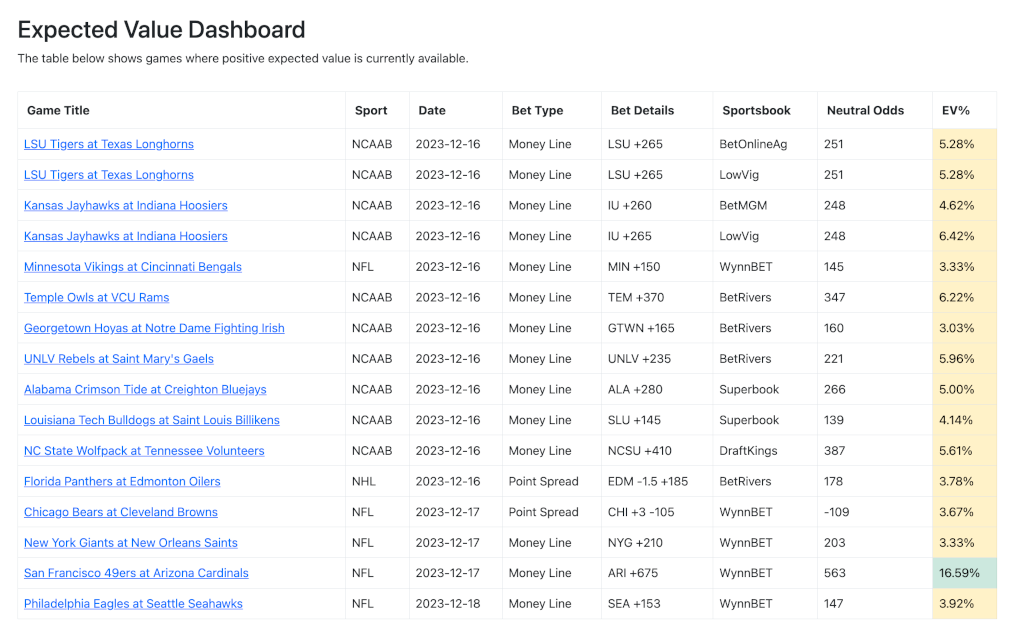Are you tired of the rollercoaster ride of sports betting, where one win can be quickly overshadowed by a big loss? The key to maintaining a steady and sustainable approach to sports betting lies in finding the balance between risk and reward. In this article, we’ll explore how using a balanced approach for determining the size of your sports bets can help you achieve long-term success. Instead of being swayed by the odds offered by the sportsbook, imagine having an equal risk per bet, regardless of whether you’re wagering on a favorite or an underdog. It’s not about hitting home runs with every bet; it’s about playing smart and staying in control.
By adopting this method, you can take control of your bankroll management and minimize the impact of losing streaks while maximizing profits during winning periods. We’ll delve into practical strategies for implementing this balanced approach, including calculating unit sizes based on your overall bankroll and incorporating discipline into your betting habits. Whether you're new to sports betting or looking to refine your current strategy, understanding how to maintain equilibrium in sizing your bets is essential for long-term profitability and enjoyment in this exciting pastime. So, let's embark on this journey together—where consistency trumps impulsivity and measured risks lead to sustainable rewards.
Why do sports bettors think in terms of units rather than dollars?
In the world of sports betting, a unit is a standardized measurement used to represent an individual bettor's stake. This system allows bettors to manage their bankroll more effectively and minimize risk by keeping their wager sizes consistent relative to their overall budget. Thinking in terms of units rather than dollars also helps bettors focus on the percentage of their bankroll being wagered, rather than getting emotionally attached to specific dollar amounts.
Furthermore, using units provides a psychological advantage for sports bettors by detaching them from the actual dollar value at stake. This approach encourages discipline and strategic decision-making based on probabilities and expected value rather than arbitrary monetary figures. By embracing the unit system, sports bettors can develop a more systematic and sustainable approach to their betting endeavors while staying committed to long-term success rather than short-term gains.
What percentage of your bankroll should a unit be?
When it comes to sports betting, one of the most debated topics among bettors is how much of their bankroll they should risk as one unit. While some argue for a conservative approach of 1-2% per unit, others advocate for a more aggressive stance with 5-10% per unit. However, there isn't a one-size-fits-all answer, as the optimal percentage varies based on individual risk tolerance, betting strategy, and overall financial situation.
For those with a higher appetite for risk and confidence in their predictive abilities, using a larger percentage of the bankroll per unit may seem appealing. On the other hand, a more cautious bettor may opt for smaller units to minimize potential losses. It's crucial to carefully assess your own comfort level and long-term goals before determining the ideal percentage for your bankroll. Ultimately, finding the right balance between risk and reward is key when deciding how much of your bankroll to allocate as one unit in sports betting.
Personally, I find that a bankroll unit size of 2% works best for me. This size enables me to steadily increase my bankroll when I am consistently winning, without the worry of depleting it completely.
What is the Consistent Bet Sizing strategy?
Consistent bet sizing is a strategy that involves placing the same amount of money on every sports bet. This approach aims to minimize losses and manage risk by avoiding disproportionately large wagers that could lead to significant financial setbacks. By maintaining a consistent betting size, sports bettors can uphold discipline and avoid emotional decision-making, which often leads to irrational and impulsive bets.
Furthermore, keeping every sports bet the same size fosters a more strategic and calculated approach to betting. It encourages bettors to focus on their analysis of games and odds rather than being swayed by emotions or external influences. Additionally, this method allows for better bankroll management, ensuring that potential losses are controlled while maximizing opportunities for long-term profitability. Ultimately, consistent bet sizing promotes responsible gambling practices and helps individuals develop a more sustainable betting strategy in the competitive world of sports gambling.
What are the downsides to consistent bet sizing?
One major drawback of the consistent bet sizing strategy is the potential impact of negative odds on a bettor's overall profitability. When consistently betting at the same size regardless of the odds given, one may find themselves risking more than necessary on bets with lower potential returns. This can lead to a reduction in long-term profits and hinder effective risk management strategies.
In addition, consistent bet sizing may not account for the nuances of betting on longshots or underdogs. While these high-risk bets can yield lucrative returns when successful, employing a rigid bet sizing approach may detract from maximizing profit potential in such situations. An adaptable betting strategy that considers the specific odds and inherent risk associated with backing longshots or underdogs could prove more advantageous in capturing value in these instances. By recognizing the impact of negative odds and adjusting bet sizes accordingly to exploit opportunities presented by longshots or underdogs, bettors can strive to optimize their overall profitability and navigate diverse wagering scenarios effectively.
What is the Bet To Win sizing strategy?
The "bet to win" bet sizing strategy is a calculated approach that focuses on selecting bet sizes that ensure you will win one unit per play. This strategy involves carefully analyzing the odds and potential outcomes of a bet to determine the optimal amount to wager in order to secure a one-unit profit. By strategically adjusting the size of your bets based on the perceived likelihood of winning, you can mitigate potential losses and maximize your returns over time. For example, if your betting unit size is $100 and you're placing at bet at -110 odds, this approach would require you to bet $110 in order to win $100. Obviously, if you lose the bet you are losing 1.1 units, rather than 1 unit.
What is the Balanced Betting sizing strategy?
The balanced betting sizing strategy is a sophisticated approach that aims to strike a perfect equilibrium between the potential winnings and the risk involved in a bet. This method involves carefully analyzing the odds, determining the amount of risk one is willing to take, and calculating the desired win amount. By harmonizing these elements, bettors can achieve an equal average between their potential winnings and the level of risk they are exposed to, thereby creating a more balanced betting portfolio.
Adopting a balanced betting sizing strategy reinforces the importance of long-term sustainability in betting activities. Rather than focusing solely on short-term gains or losses, this method encourages bettors to optimize their chances for success over an extended period by maintaining consistent and calculated bet sizes. In essence, it promotes responsible betting practices while also enhancing the overall effectiveness of a person's wagering endeavors.
The table below shows how to adopt a balanced bet sizing strategy across a variety of different sports bets.
| Bet Amount | Bet Odds | To Win | Avg of Risk & To Win |
|---|---|---|---|
| $100 | +100 | $100 | $100 |
| $89 | +125 | $111 | $100 |
| $83 | +141 | $117 | $100 |
| $67 | +200 | $134 | $100 |
| $105 | -110 | $95 | $100 |
| $109 | -120 | $91 | $100 |
| $120 | -150 | $80 | $100 |
| $143 | -250 | $57 | $100 |
Summary of the Balanced Bet Sizing strategy
In conclusion, the Balanced Betting sizing strategy offers a unique and effective approach to managing betting amounts. By taking into account odds, risk amount, and potential winnings, this strategy aims to strike a balance between risk and reward. Unlike consistent or bet to win sizing strategies, Balanced Betting seeks to provide a more equitable average between winnings and risk, ultimately leading to more sustainable and successful betting outcomes. As such, it represents a valuable tool for both novice and experienced bettors looking to optimize their betting approach. Embracing the Balanced Betting sizing strategy can help bettors make more informed decisions and improve their overall profitability in the long run. It is certainly worth considering as part of a comprehensive betting strategy.






